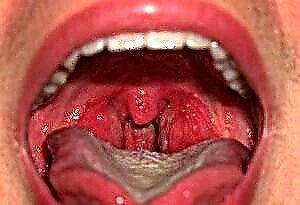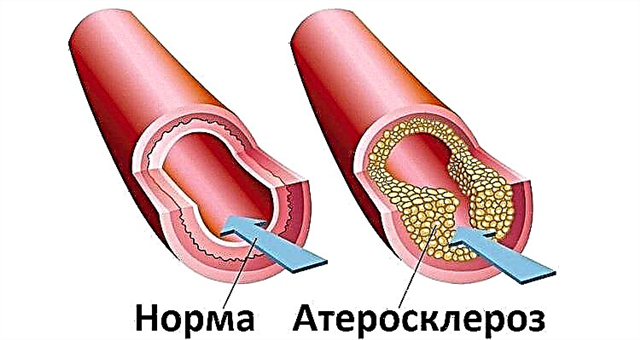Diagnosis of any disease begins with the study of the patient's complaints and highlighting the leading one. A set of symptoms, when a sore throat, a head and a temperature of 37-39 degrees are sore, is present in many diseases, which complicates the diagnosis. An important role in such cases is played by additional signs, as well as the results of an objective examination and laboratory diagnostics.
 Most often, these signs characterize the following infectious diseases:
Most often, these signs characterize the following infectious diseases:- ARVI;
- sore throat;
- Infectious mononucleosis;
- childhood infections.
Since both viruses and bacteria are involved in the development of these diseases, the treatment approaches are different. To prescribe the correct treatment, it is necessary to clarify the nature of the disease, to determine the pathogen. To do this, you should collect all the signs and carry out differential diagnostics.
ARVI
SARS is the most common disease, in the development of which about 200 different viruses can take part. In this case, the clinical picture is similar and is characterized by
- acute development of the process;
- malaise;
- muscle pain and joint aches;
- soreness when turning the eyeballs;
- coryza with profuse mucous discharge;
- nasal congestion;
- dry cough;
- development of hyperthermia up to 38-39 degrees.
As for the pain in the throat, the sick patient describes them as tickling, scratching. An objective examination of the throat cavity allows one to detect hyperemic mucosa, several edematous tonsils, the absence of purulent deposits on them.
An increase in regional lymph nodes for ARVI is uncommon.
This symptom can develop only in the presence of complications, otitis media, tonsillitis.
The largest number of ARVI cases is observed in the autumn-winter period. In some cases, the prevalence of the disease takes on the character of an epidemic. In these conditions, it is not difficult to clarify the diagnosis. The diagnosis of ARVI is also facilitated by the fact that after 5-7 days a regression of clinical signs is observed, the patient recovers.
Infectious mononucleosis
One of the factors that make it possible to differentiate infectious mononucleosis is the duration of the disease. Clinical signs persist for 10-15 days. In some cases, - for several weeks, which distinguishes the disease from ARVI.
This viral infection is also characterized by a sore throat, malaise, weakness, headache and a temperature of 37-38 degrees. Redness and enlargement of the tonsils are a constant symptom. Additional symptoms that aid diagnosis are
- an increase in regional, inguinal and axillary lymph nodes;
- the presence of a rash;
- enlargement of the liver and spleen.
To confirm the diagnosis, laboratory diagnostics are used to identify positive liver function tests, changes in the general blood test. Serodiagnosis of infectious mononucleosis is also informative.
Childhood infections
Infections in children are also accompanied by symptoms such as malaise, headache, and sore throat. For adults, such diseases are atypical, but they occur and are characterized by a severe course with pronounced symptoms of intoxication. Hyperthermia can reach 39 degrees.
can reach 39 degrees.
An obligatory symptom of childhood infections, measles, chickenpox, scarlet fever, rubella, is the presence of a characteristic rash.
The epidemiological factor plays an important role in the diagnosis of the disease. The patient is contagious throughout the treatment. Given the airborne transmission route, you can get infected by talking, coughing. In cases of chickenpox, the contagiousness of the disease is so high that it is possible to get sick while being in the adjacent premises with an infected patient.
Angina
Among infectious processes, angina occupies a special place in connection with the danger of this disease in relation to early and late complications. The cause of its occurrence is a bacterial pathogen, hemolytic streptococcus. It can be clarified by bacteriological examination of scraping from the tonsils and a smear from the pharynx. In addition, inoculation of the contents helps to determine the sensitivity of the pathogenic bacteria to antibiotics.
The accompanying symptoms in this case are the following signs:
- significant deterioration in general condition, severe weakness;
- an increase in body temperature up to 39 degrees;
- sharp pain and enlargement of regional lymph nodes.
Patients describe sore throat as persistent. It intensifies when swallowing, gives to the neck and ear. Due to the severe pain syndrome, it is difficult to open the mouth. The phenomena of intoxication are expressed. Patients are worried about severe weakness, chills, headache.
Pharyngoscopy is of great help in diagnosing this condition. An objective examination of the throat cavity allows one to detect enlarged, edematous tonsils. With follicular and lacunar angina, there is a dirty gray discharge that fills the corresponding structures of the tonsils.
The purulent form of angina is characterized by a severe course.
The temperature can reach 40 degrees. There are changes in the general blood test, indicating the development of a bacterial process: an increase in ESR up to 30-40 mm / h, leukocytosis up to 15-20, a shift in the blood formula to the left.
Inflammatory processes
Subfebrile body temperature, headache and sore throat are also characteristic of inflammatory processes occurring in the throat cavity. They can be caused by various pathogenic microorganisms, viruses, bacteria, fungi. Moreover, in many cases, their development is associated with the activation of their own pathogenic microorganisms. Such diseases are
- pharyngitis;
- laryngitis;
- tonsillitis.
The provoking factors in this case are
- hypothermia;
- polluted inhaled air, the presence of chemical impurities in it;
- reduced immunity;
- the presence of concomitant severe pathology;
- bad habits.
The impact of these unfavorable components leads to the fact that the patient develops inflammatory processes in the throat. Depending on the predominance of a particular localization of the process, the clinical symptoms are different in each case.
Tonsillitis is a lesion of the palatine tonsils, lymphoid formations that take  active participation in the development of immunity. With untimely and incorrect treatment, the disease becomes chronic. Such a course is dangerous not only for its relapses, occurring with pronounced symptoms of intoxication, a sore throat, an increase in body temperature to 38-39 degrees. Tonsils, affected by a prolonged inflammatory process, through immune reactions have a negative effect on the entire body.
active participation in the development of immunity. With untimely and incorrect treatment, the disease becomes chronic. Such a course is dangerous not only for its relapses, occurring with pronounced symptoms of intoxication, a sore throat, an increase in body temperature to 38-39 degrees. Tonsils, affected by a prolonged inflammatory process, through immune reactions have a negative effect on the entire body.
In addition to a sore throat, a headache, and a prolonged subfebrile condition, additional symptoms are
- fatigue, physical and mental;
- pain and disturbances in the work of the heart, tachycardia, interruptions;
- soreness and swelling of the joints;
- disturbances in the work of the kidneys.
With pharyngitis, the general condition of the patient is slightly impaired. There is weakness, headache, and a decrease in appetite. The main symptom of pharyngitis, in addition to pain in the throat, subfebrile condition, is a prolonged dry cough that interferes with sleep and good rest.
On objective examination, the mucous membrane of the posterior pharyngeal wall and palatine arches looks hypermucous, edematous. There are no signs of an inflammatory process in the tonsils.Pharyngitis is characterized by the scarcity of objective changes in comparison with the existing exhausting cough.
Inflammation of the larynx is one of the manifestations of ARVI. In addition, laryngitis can be an independent disease that is caused by overstrain of the vocal cords or caused by exposure to pathogenic microbes, hypothermia, inhalation of polluted air. A typical sign of laryngitis is a change in voice, its hoarseness. As the process progresses, it may become silent.
Patients complain of constant sore throat, scratching, desire to cough up. The acute process is accompanied by a sore throat, aggravated by swallowing, headache, fever up to 37.3-37.5 degrees. The mucous membrane of the larynx looks sharply hyperemic.
With the hypertrophic form of laryngitis, growths the size of a pinhead are noted on the vocal cords. It is they who contribute to a change in the timbre of the voice, its hoarseness. The atrophic form of laryngitis is less common. In this case, an objective examination of the throat cavity reveals a thinning of the laryngeal mucosa. Patients complain of dry mouth and persistent dry cough.
A complex of symptoms, such as headache, sore throat and fever, may indicate the development of a pathological process  not only in the throat cavity. Such signs characterize the development of acute purulent otitis media at the pre-perforative stage. Pain syndrome in the ear is characterized by aching, twitching pain radiating to the neck and throat. In cases where there is no suppuration, determining the localization of the pathological process may be difficult. An otolaryngologist will be able to clarify the diagnosis, who will conduct a pharyngoscopy and otoscopy.
not only in the throat cavity. Such signs characterize the development of acute purulent otitis media at the pre-perforative stage. Pain syndrome in the ear is characterized by aching, twitching pain radiating to the neck and throat. In cases where there is no suppuration, determining the localization of the pathological process may be difficult. An otolaryngologist will be able to clarify the diagnosis, who will conduct a pharyngoscopy and otoscopy.
In order to prescribe the correct treatment for a patient who has a sore throat, head and fever, it is necessary to clarify additional symptoms, to collect an anamnesis of the disease. Pharyngoscopy plays an essential role in this case. An otolaryngologist should conduct a study, evaluate its results, in the future, prescribe treatment.

 Most often, these signs characterize the following infectious diseases:
Most often, these signs characterize the following infectious diseases:

